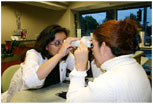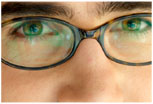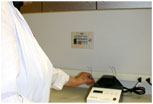Frames are identified by manufacturer/designer, model number or name, size, and color information. Size information contains the horizontal measurement of each lens in millimeters (i.e. 47) and bridge size (the distance between the lenses) i.e. 18. This information can help you in sizing a frame for your face. To better understand the frame size, double the first number and add the second. This will give you the distance across the full front of the frame. For example, a frame size of 47/18 means that the frame measures 112 mm across (47 x 2 + 18 = 112).
Frame size may also contain the temple length (including the portion going behind the ear) in millimeters such as 145. Therefore a frame size would be written 47/18 or 47-18 or 47/18-145. Color may be noted as a description such as gunmetal, other manufacturers use a color number. NeoVision’s opticians will help you in choosing the right size frame for the best possible fit.

 Inter-pupillary distance (PD) is the distance from the center of the pupil in one eye to the center of the pupil in the other eye. A PD measurement ensures that the center of the lenses line up with the center of your pupil. Before your prescription lenses are cut into the shape of your frame, the pupillary distance needs to be measured. This measurement is then used so that the optical center of each lens can be lined up with your pupils in order to give optimal visual clarity.
Inter-pupillary distance (PD) is the distance from the center of the pupil in one eye to the center of the pupil in the other eye. A PD measurement ensures that the center of the lenses line up with the center of your pupil. Before your prescription lenses are cut into the shape of your frame, the pupillary distance needs to be measured. This measurement is then used so that the optical center of each lens can be lined up with your pupils in order to give optimal visual clarity.
 Anti-reflective coating
Anti-reflective coating Lenses with
Lenses with  UV400 means that the lens blocks all lightwaves 400 nanometers and below. 400 nanometers is typically referred to as the point where UV light starts. Anything below 400 nanometers is considered to be in the ultraviolet range.
UV400 means that the lens blocks all lightwaves 400 nanometers and below. 400 nanometers is typically referred to as the point where UV light starts. Anything below 400 nanometers is considered to be in the ultraviolet range. Wear photogrey, light tint,
Wear photogrey, light tint,  Your bifocal power needs to be adjusted. Schedule an eye exam with your eye doctor.
Your bifocal power needs to be adjusted. Schedule an eye exam with your eye doctor. There is evidence that sunlight exposure plays a role in certain eye diseases, such as
There is evidence that sunlight exposure plays a role in certain eye diseases, such as  Children are at a higher risk from the harmful effects of UV since they generally spend more time outside in the sun. Select sunglasses that suit your child’s active lifestyle. The lenses should be impact resistant i.e. made of polycarbonate.
Children are at a higher risk from the harmful effects of UV since they generally spend more time outside in the sun. Select sunglasses that suit your child’s active lifestyle. The lenses should be impact resistant i.e. made of polycarbonate. Sunglasses are used for three main reasons: health, performance, and fashion. A quality pair of sunglasses should provide all three functions. Lenses should be of high optical clarity and protect your eyes from harmful effects of
Sunglasses are used for three main reasons: health, performance, and fashion. A quality pair of sunglasses should provide all three functions. Lenses should be of high optical clarity and protect your eyes from harmful effects of